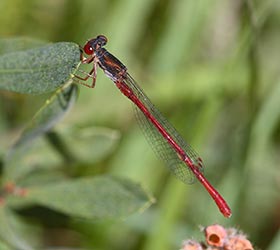Small Red Damselfly (Ceriagrion tenellum)
When: Late May or early June to late September
How many: Nationally scarce, but in places abundant in the New Forest

on bog myrtle
The Small Red Damselfly, just like the Dartford warbler, wild gladiolus and silver-studded blue butterfly, could quite justifiably be described as a New Forest speciality species, that is a nationally scarce species that is found in reasonable numbers in the New Forest.
These tiny, delicate insects are primarily denizens of wet, lowland heaths which, given the scarcity of this type of habitat in much of modern Britain, explains their limited distribution. But in the New Forest they are locally abundant, so-much-so that this area is considered to be their UK stronghold.
On the wing from late May or early June until mid to late September, but with a peak from mid- or late June into July, they are tiny creatures with a wingspan of around 3.5 centimetres and a length of 3 centimetres. The abdomens of male Small Red Damselflies are predominantly bright red, whilst females often feature some black marking, particularly in the middle segments and at the tip.
As with many other dragonflies and damselflies, warm sunshine is needed to encourage significant activity. Males are territorial, but will often only defend a perch against competing males whilst tolerating presence in the wider vicinity.
References:
A Guide to the Dragonflies of Great Britain: Dan Powell
Dragonflies and Damselflies of Britain and Northern Europe: Bob Gibbons
The Dragonflies of Hampshire - John Taverner, Steve Cham, Alan Hold, et al
More links
Other related links
Search this site

Sadly, 58 animals were killed - 35 ponies, 13 cows, 8 donkeys and 2 sheep, whilst a further 32 were injured - 3 pigs, 9 donkeys, 11 cows and 9 ponies.
(Forty-three accidents occurred in daylight, 15 at twilight and 101 in the dark. Twenty-seven accidents were not reported by the driver involved).
Here's just one horrific example - Three donkeys killed in collision with van at notorious New Forest blackspot (Advertiser and Times)

